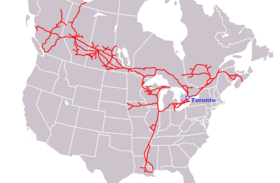MacMillan Yard
| MacMillan Yard | |
|---|---|
|
Aerial photo of the marshalling yard from 2008 (view to NW ) |
|
| Data | |
| Operating point type | Marshalling yard |
| Design | Terminus |
| opening | 1965 |
| location | |
| Place / district | Vaughan |
| province | Ontario |
| Country | Canada |
| Coordinates | 43 ° 48 '43 " N , 79 ° 30' 40" W |
| List of train stations in Canada | |
The MacMillan Yard is a marshalling yard of the Canadian National Railway (CN) in Vaughan , Ontario . It is located about 20 kilometers north of downtown Toronto and extends for six kilometers in a north-south direction. The Toronto Yard , which consists of two flat stations , was built in the mid-1960s (MacMillan Yard since 1975) and almost fully automated in the 1990s with remote-controlled shunting locomotives and rail brakes . It is the largest marshalling yard in the CN network with a daily capacity of 3,000 freight wagons .
history

In the early 1960s, the two Canadian Class 1 railroad companies each began building a large marshalling yard in the Greater Toronto Area . The CPR Toronto Yard of the Canadian Pacific Railway (CPR) in Agincourt ( Scarborough ) opened in 1964 and the Toronto Yard of the CN in Vaughan a year later in May 1965. In the course of the new construction, the freight traffic of the CN from the Mimico Yard near the city center was opened relocated the new marshalling yard in the north; the site of the former train station in Mimico is now mainly used by GO Transit (Willowbrook Yard) and VIA Rail Canada (VIA Toronto Maintenance Center) . In 1975 the yard was named MacMillan Yard in honor of the former President of CN Norman J. MacMillan .
At the end of the 1980s, the CN developed a system for radio remote control of shunting locomotives , with which the majority of all CN and CPR marshalling yards in Canada were equipped in the 1990s. This enabled the automation of the stations to be further advanced, with the locomotives being operated today by ground staff using portable control modules (beltpack) and the train formation process behind the drainage mountain using track brakes remotely controlled by the signal box . The entire maneuvering process is monitored by the signal box with the aid of a computer. In addition, the locomotives and freight wagons are equipped with transponders and their positions are constantly monitored by GPS , which means that the shunting locomotives can automatically be stopped in an emergency when leaving defined areas. In the 2000s the system caught on in the USA and is now used by all Class 1 railroad companies.
description

The marshalling yard was designed as a terminal station and consists of two flat stations that are one behind the other in north-south direction; the entry and exit groups are arranged on the side. The station is approached and exited from the south. For the shunting process, the wagon trains to be dismantled are pulled from the drive-in group over two pull-out tracks in the north ( stump tracks ) behind the station and then pushed south over the first drainage mountain ; this is also designed on two tracks for parallel operation. The train formation then takes place in the first directional harp in the north or after the second single-track drainage mountain in the southern directional harp. By the end of the 20th century these had 72 or 50 tracks. The configuration was changed in the 2010s so that the southern direction harp was reduced to 33 tracks for an additional exit group with four tracks. The northern main direction group is divided into eight subgroups with nine tracks each, with the middle ones sharing one track and the total number is therefore only 71; Since some of the middle tracks are required as access to the second drainage mountain, the number of tracks that can be used is even lower.
The MacMillan Yard covers an area of around 160 hectares and is the largest marshalling yard in the CN network. With the closure of the large marshalling yards in Montreal (Taschereau Yard) and Edmonton (Walker Yard) it is now one of four remaining large marshalling yards of the CN, two of which are in the USA. The northern flat station has a daily throughput of around 2000 freight wagons and the southern one of around 1000, which is only used for local freight traffic.
See also
Web links
Individual evidence
- ^ Canadian National's Mimico Yard. on Railpictures.ca. Retrieved May 4, 2019.
- ↑ Derek Boles: CN Toronto Yard. Toronto Railway Historical Association on Facebook, February 5, 2018. Retrieved May 3, 2019.
- ^ Leo Ryan: CN Subsidiary Develops Beltpack to Operate Locomotives Remote. JOC.com, November 20, 1994. Retrieved May 4, 2019.
- ↑ Railway Investigation Report R07T0270 (17 September 2007). Transportation Safety Board of Canada. Retrieved May 4, 2019.
- ^ A b Railway Investigation Report R10T0020 (February 9, 2010). Transportation Safety Board of Canada. Retrieved May 4, 2019.
- ↑ Greg Gormick: Rebuilding railway yards, by bits and bytes. Brotherhood of Locomotive Engineers and Trainmen, June 21, 2004. Retrieved May 4, 2019.
- ↑ Canac Inc .: BELTPACK (R) locomotive remote control systems now number over 500 in North America - CSXT orders 75 BELTPACK (R) LRC Systems. Brotherhood of Locomotive Engineers and Trainmen, March 20, 2003. Retrieved May 4, 2019.
- ↑ Michael Rhodes: North American Railyards. Voyageur Press, 2014, ISBN 978-0-76034-609-9 , pp. 119-122.
- ↑ Michael Rhodes: North American Railyards. Voyageur Press, 2014, ISBN 978-0-76034-609-9 , p. 113.


